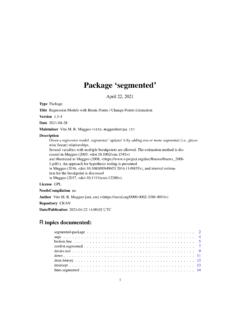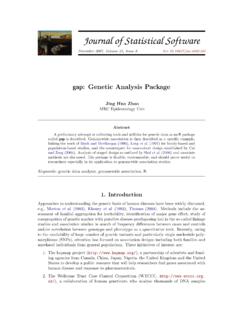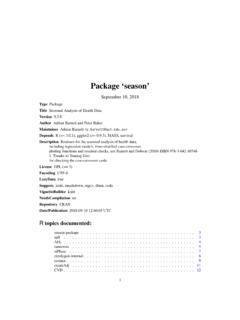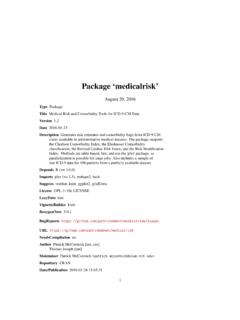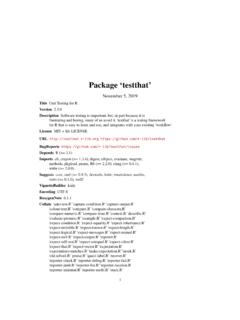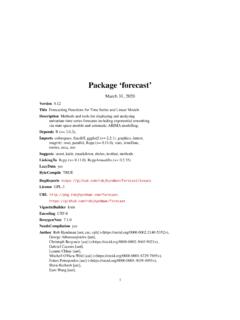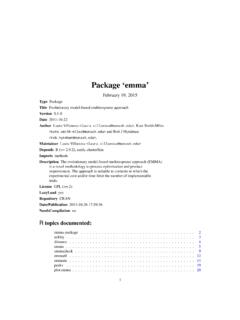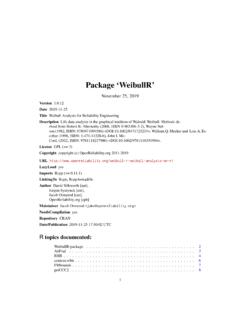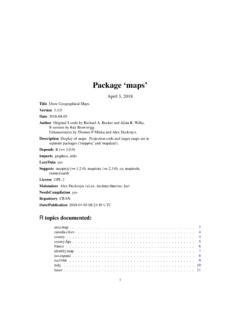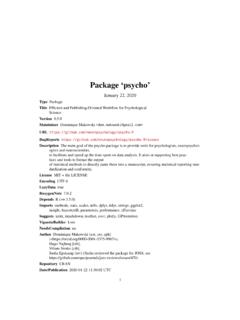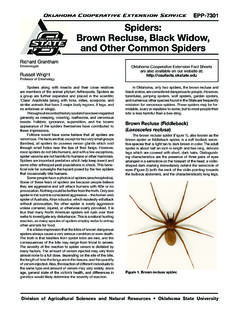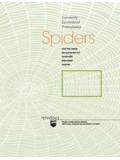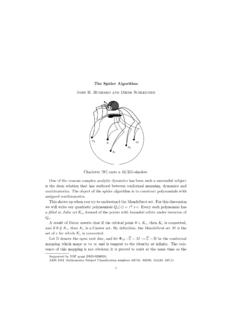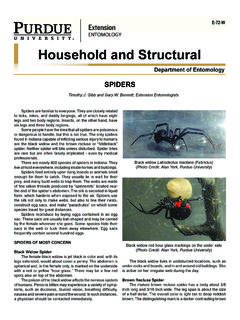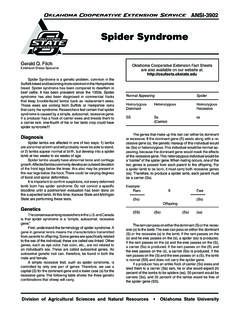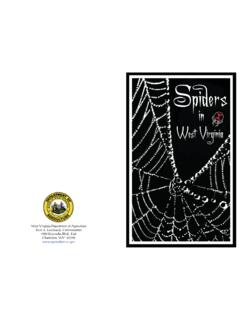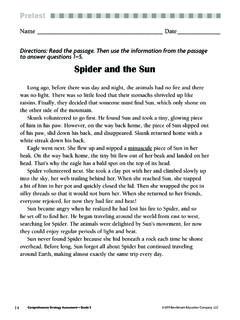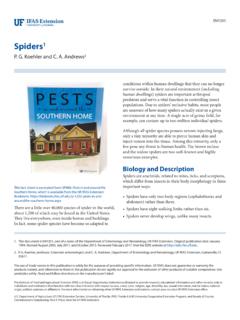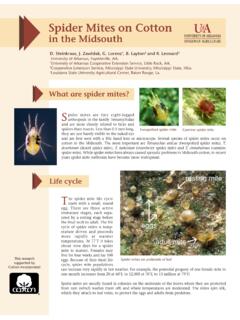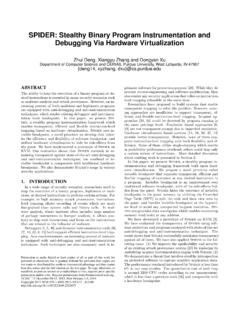Transcription of Package ‘spider’ - The Comprehensive R Archive Network
1 Package spider February 16, 2018 TypePackageTitleSpecies Identity and Evolution in Brown, Rupert Collins, Stephane Boyer, Marie-Caroline Lefort, Jagoba Malumbres-Olarte, Cor Vink, Rob CruickshankMaintainerRupert A. of species limits and DNA barcoding data. Included are functions for generat-ing important summary statistics from DNA barcode data, assessing specimen identification effi-cacy, testing and optimizing divergence threshold limits, assessment of diagnostic nu-cleotides, and calculation of the probability of reciprocal monophyly. Additionally, a slid-ing window function offers opportunities to analyse information across a gene, of-ten used for marker design in degraded DNA studies. Further information on the pack-age has been published in Brown et al (2012) < >.
2 LicenseMIT + file LICENSELazyLoadyesImportsape, pegas, graphics, stats, 19:33:47 UTCR topics documented: spider - Package ..3anoteropsis ..4bestCloseMatch ..4blockAlignment ..6cgraph ..7chaoHaplo ..812 Rtopics documented:checkDNA ..9dataStat .. 10dolomedes .. 11haploAccum .. 11heatmapSpp .. 14localMinima .. 15maxInDist .. 16minInDist .. 17monophyly .. 19monophylyBoot .. 20nearNeighbour .. 22nonConDist .. 24nucDiag .. 26ordinDNA .. 27paa .. 33polyBalance .. 34rankSlidWin .. 39rmSingletons .. 41rnucDiag .. 42rosenberg .. 43salticidae .. 45sarkar .. 46seeBarcode .. 47seqStat .. 48slideAnalyses .. 49slideBoxplots .. 51slideNucDiag .. 53slidingWindow.
3 54sppDist .. 55sppDistMatrix .. 56sppVector .. 60tclust .. 61threshID .. 62threshOpt .. 64tiporder .. 65titv .. 67woodmouse .. 68 Index70spider-package3spider-packageSpec ies Identity and Evolution in RDescriptionSpider: SPecies IDentity and Evolution in R, is an R Package implementing a number of usefulanalyses for DNA barcoding studies and associated research into species delimitation and specia-tion. Included are functions for generating summary statistics from DNA barcode data, assessingspecimen identification efficacy, and for testing and optimising divergence threshold limits. In termsof investigating evolutionary and taxonomic questions, techniques for sliding window, populationaggregate, and nucleotide diagnostic analyses are also complete list of functions can be displayed withlibrary(help= spider ).
4 More information, including a tutorial on the use of spider can be found :spiderType: :2017-05-13 License:GPLLazyLoad:yesA few of the key functions provided by spider :DNA barcoding:bestCloseMatch,nearNeighbour,t hreshID,threshOpt, window:slidingWindow,slideAnalyses, diagnostics:nucDiag, (s)Samuel Brown, Rupert Collins, Stephane Boyer, Marie-Caroline Lefort, Jagoba Malumbres-Olarte,Cor Vink, Rob CruickshankMaintainer: Samuel Brown S. D. J., Collins R. A., Boyer S., Lefort , Malumbres-Olarte J., Vink C. J., & Cruick-shank R. H. 2012. spider : an R Package for the analysis of species identity and evolution,with particular reference to DNA barcoding. _Molecular Ecology Resources_ 12:562-565. Alsoape- Package , oxidase I (COI) sequences of New Zealand _Anoteropsis_speciesDescriptionA set of 33 sequences of the mitochondrial protein-coding gene cytochrome oxidase I from 20species of the New Zealand wolf spider genusAnoteropsis(Lycosidae) and two species ofArtoriaas outgroups.
5 The sequences are available on GenBank as accession numbers AY059961 DNAbin object containing 33 sequences with a length of 409 base pairs stored as a , C. J., and Paterson, A. M. (2003). Combined molecular and morphological phylogeneticanalyses of the New Zealand wolf spider genus _Anoteropsis_ (Araneae: Lycosidae). _MolecularPhylogenetics and Evolution_ *28* of identification accuracyDescriptionTests of barcoding efficacy using distance-based (distobj, sppVector, threshold = , names = FALSE)ArgumentsdistobjA distance object (usually ).sppVectorVector of species names. cutoff for identifications. Default of (1%).namesLogical. Should the names of the nearest match be shown? Default of functions test barcoding efficacy.
6 All sequences must be identified prior to testing. Eachsequence is considered an unknown while the remaining sequences in the dataset constitute theDNA barcoding database that is used for identification. If the identification from the test is thesame as the pre-considered identification, a correct result is the "best close match" analysis of Meier et al. (2006), considering theclosest individual unless it is further than the given threshold, which results in no than one species tied for closest match results in an assignment of "ambiguous". Whenthe threshold is large, this analysis will return essentially the same result asnearNeighbour. Ifnames = TRUE, a list is returned containing the names of all species represented by specimenswithin the the closest individual and returns if their names are the same (TRUE) ordifferent (FALSE).
7 Ifnames = TRUE, the name of the closest individual is returned. Ties aredecided by majority a threshold-based analysis, similar to that conducted by the "Identify Specimen"tool provided by the Barcode of Life Database ( ). It is more inclusive thanbestCloseMatch, considering ALL sequences within thegiven threshold. Ifnames = TRUE, a list is returned containing the names of all species representedby specimens within the functions are not recommended as identification tools, though they can be used as such whennames = a character vector giving the identification status of eachindividual."correct"The name of the closest match is the same"incorrect"The name of the closest match is different"ambiguous"More than one species is the closest match (bestCloseMatch), or is within thegiven threshold (threshID)"no id"No species are within the threshold distancenearNeighbourreturns a logical vector or (ifnames = TRUE) the name for the nearest (s)Samuel Brown R.
8 , Shiyang, K., Vaidya, G., & Ng, P. (2006). DNA barcoding and taxonomy in Diptera: atale of high intraspecific variability and low identification success. _Systematic Biology_ *55* (5) AlsonearNeighbour,threshID, ,sppVectorAlso ashelp, ~~~6blockAlignmentExamplesdata(anoterops is)anoDist <- (anoteropsis)anoSpp <- sapply(strsplit(dimnames(anoteropsis)[[1 ]], split = "_"),function(x) paste(x[1], x[2], sep = "_"))bestCloseMatch(anoDist, anoSpp)bestCloseMatch(anoDist, anoSpp, threshold = )nearNeighbour(anoDist, anoSpp)nearNeighbour(anoDist, anoSpp, names = TRUE)threshID(anoDist, anoSpp)threshID(anoDist, anoSpp, threshold = )data(dolomedes)doloDist <- (dolomedes)doloSpp <- substr(dimnames(dolomedes)[[1]], 1, 5)bestCloseMatch(doloDist, doloSpp)bestCloseMatch(doloDist, doloSpp, threshold = )nearNeighbour(doloDist, doloSpp)nearNeighbour(doloDist, doloSpp, names=TRUE)
9 ThreshID(doloDist, doloSpp)threshID(doloDist, doloSpp, threshold = )blockAlignmentMake all sequences the same lengthDescriptionCoerces all sequences in a DNAbin object to the same (DNAbin, mode = "shortest", range = NULL, fill = "")ArgumentsDNAbinAn object of classDNAbinmodeCharacter vector. Options of "shortest" or "longest"rangeNumeric vector of length 2. Index of the bases where the new alignment shouldbegin and endfillCharacter to fill the extra bases in short sequences. Default of "" (blank). Rec-ommend that only "-" (gap) or "?" be usedcgraph7 DetailsWhenmode = "shortest", the alignment is truncated at the length of the shortest sequence. Whenmode = "longest", the alignment is extended to the end of the longest sequence, with shortersequences filled in with"fill" DNAbin object in matrix (s)Samuel Brown mode = "longest")blockAlignment(salticidae, mode = NULL, range = c(200, 600))graphics::image(blockAlignment(salt icidae))graphics::image(blockAlignment(s alticidae, mode = "longest"))graphics::image(blockAlignmen t(salticidae, mode = NULL, range = c(200, 600)))cgraphComplete graphDescriptionCreates a complete graph for the given cloud of (x, y = NULL.
10 ArgumentsxX values, or a matrix with two columns containing X and Y values. Can be left empty ifxis a arguments to be passed not given,xis required to be a matrix containing both x and y a complete graph between the given (s)Samuel Brown <- runif(15)y <- runif(15)graphics::plot(x, y)cgraph(x, y)M <- cbind(x, y)cgraph(M[1:10,], col = "blue")chaoHaploChao estimator of haplotype numberDescriptionCalculates the Chao1 estimate of the number of haplotypes in a population based on the total numberof haplotypes present, and the number of singletons and doubletons in the (DNAbin)ArgumentsDNAbinAn object of class DNAbin .DetailsThe function assumes a large number of specimens have been sampled and that duplicate haplotypeshave not been removed.
